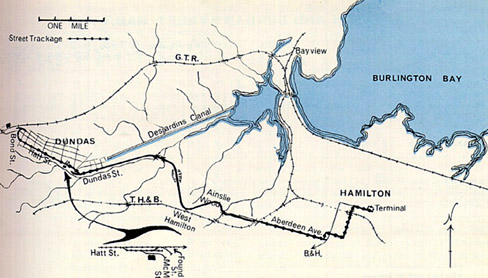HAMILTON & DUNDAS STREET RAILWAY

THE HEART OF THE CITY
HAMILTON & DUNDAS STREET RAILWAY

In 1873, an enterprising resident of Dundas named Britton Bath Osler organized a
company to build a railway. He had a meeting with many prominent citizens from Dundas and
Hamilton on May 11, 1875, at George Bamberger’s Hotel. At this meeting, they
discussed the prospects of a railway. In the same year, the Hamilton & Dundas Street
Co. was incorporated to build a steam–operated light railway between the two towns.
B. B. Osler was the promoter. 
Osler subscribed $1,500 worth of stock in favour of the railway. The city vouched that they would give bonuses of $10,000 towards the scheme. The Ontario Legislature passed an Act in 1876 to incorporate the railway and on August 9, 1877, construction of the line began. But soon, another problem arose. The project had run out of money, meaning that more stocks had to be sold.
The line took longer to build than anticipated, but by January 16, 1879 the rail-laying
was completed and a steam-operated railway service commenced on the seven-mile stretch
between Hamilton and Dundas. The formal opening took place on May 29, 1879, after four
years of difficulties. 
The type of engines used by the railway were known as "steam dummies." They were called dummies because originally they were not equipped with bells and whistles and therefore could not "talk." The engines were well enclosed from view to make them less frightening to horses. Horses were considered to have the right of way on city streets. There were four dummy engines in total.
Crowds often used the railway on Sundays for picnics. Monthly tickets and season passes could be obtained and special group exclusion rates could be arranged for picnic parties heading to Ainslie’s Woods or Dundas Driving Park. The fare was 15 cents for a single ride or 25 cents for a return. Passengers could get on or off anywhere as long as they signaled. The train carried 250,000 passengers annually. The owners of the railway wanted to extend the lines to Burlington Beach and Grimsby but City Council refused. They said that Main Street was becoming too commercial and the railway posed a danger to pedestrians.
There was one accident that gave some citizens a scare. In December 1891, a girl was
hit and dragged along for some distance. She she survived the incident and had no
broken bones. But perhaps the City Council officials had little reason to worry, since as
one citizen put it, "the only accident that seems to happen is for the train to
arrive on time." 
In 1893, the railway franchise was extended for another 20 years and was given the authority to electrify, which it did in 1898. After the line became powered by electricity rather than steam, the railway was replaced by a trolley service with radial cars. In 1900 the line was absorbed by the Hamilton Cataract Power, Light and Traction Company at a price of $200,000 and the route was extended about a mile further west via Hatt and Bond Street to Fisher’s Mills.
Passenger traffic grew steadily from 165,000 in 1898 to 1,150,000 in 1920. After that year however, it began to drop. Between 1920 and 1923 the passenger load fell to half of what it had been. Deficits had appeared in 1916 and by 1922 had reached $25,000. The drop in traffic was a result of bus and auto competition after 1920. The Hamilton and Dundas Street Railway could not compete with the buses and were forced to call it quits. The service stopped on September 5, 1923. Many of the trucks were acquired by the Toronto, Hamilton, and Buffalo Railway for the continuation of freight services.
The company had operated as an electric line for 26 years, but the high cost of operating and unsatisfactory earnings affected the railway to the point where it simply could not survive.

